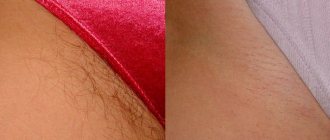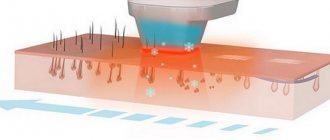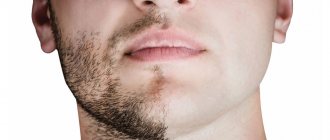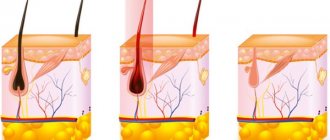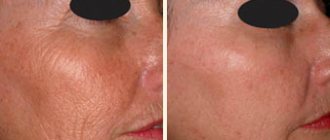- Features of laser hair removal
- Epilation frequency
- Laser hair removal for hormonal imbalances
- What else affects the number of hair removal sessions?
- Conclusion
Laser hair removal has several features that affect the frequency of sessions and the overall duration of the course. These are the features :
- the effect is concentrated on those parts of the hair that contain melanin;
- to get smooth skin, you will need to “capture” the active phase of all hair development;
- The frequency of procedures is tied to the natural life cycle of the hair.
Everything we talk about below is due to these features. It is the fact that the laser technique “adjusts” to the anatomy that guarantees a stable and long-lasting effect.
The principle of operation of the laser device
Laser hair removal is based on the absorption of light energy by melanin (the hair color pigment). The created light pulse penetrates deep into the skin and affects the hair follicle, destroying it. Light energy absorbed by melanin heats the hair along its entire length and has a detrimental effect on the hair follicle. After such a procedure, the follicle cannot receive the necessary nutrients and restore the bulb. Result: hair stops growing.
Removing excess hair in this way is most effective for those with dark hair. They are rich in melanin. Dark skin types, as well as tanned skin, do not respond well to laser hair removal, because the light from the beam will scatter throughout the skin layer without reaching the hair roots.
We advise you to pay attention!
The laser hair removal procedure should only be carried out in clinics and salons equipped with special high-quality equipment. Hair removal can only be carried out by well-trained professionals. Having decided to subject yourself to any cosmetological manipulations, check whether the institution has a license to use the appropriate devices. Otherwise, you risk getting at least a bad result, having paid a lot of money. Or acquire health problems, which is much worse.
How does hair grow?
The speed of hair regrowth, its thickness, color, structure are determined by many parameters: gender and race, weight and height characteristics of a person, age group, metabolic rate, state of the endocrine system, use of medications, general well-being of the body, and so on.
There are several stages of hair growth:
- active growth;
- death of roots;
- prolapse (resting stage);
- the birth of new hairs;
- new regrowth phase.
Thus, the hair on a person’s head can be at different stages of growth at the same time. One part (the largest) grows, the other dies and then falls out, and the third is in an embryonic state.
Conclusion: during laser hair removal, not all hair can be removed at once, but only those that were in the active growth stage at the time of the procedure. After some time, the rest of the hair begins to grow back, and the procedure has to be repeated again. This can continue until the last hair on the body is worn out. How long will it take, how many times will you need to subject yourself to unpleasant, expensive cosmetic procedures? There is no definite answer and cannot be. It all depends on the individual characteristics of each person’s body.
In addition, very often the hair does not disappear completely; in place of the removed thick, hard, dark vegetation, a light, light, sparse fluff grows back, almost imperceptible.
Contraindications
There are a number of contraindications to the laser method of getting rid of hair on the legs:
- Diabetes. Due to disrupted carbohydrate metabolism, the skin is prone to damage. After the procedure, ulcers may appear on it, which will take a long time to heal.
- A course of antibiotic treatment. Hair removal can be carried out no earlier than 2 weeks after the end of treatment.
- A course of treatment with hormonal drugs. Hormones contribute to the strengthening and active growth of hair, so hair removal during this period will be useless.
- Infections and inflammatory processes on the skin. Exposure to damaged areas with a laser can cause complications and aggravate the course of the disease.
- Epilepsy.
- Oncological neoplasms, regardless of their location in the body.
- Active phase of tuberculosis.
- Pathologies of the heart and vascular system that are in the stage of decompensation.
- Blood diseases.
It is prohibited to perform hair removal using a laser during pregnancy and breastfeeding. Firstly, due to altered hormonal levels, the procedure may not work. Secondly, during pregnancy, a woman’s sensitivity increases, which is why pain can be felt much stronger and cause stress.
Increased pain is also observed during breastfeeding. Due to prolonged discomfort, a woman may stop producing breast milk.
It is not recommended to do hair removal during acute viral diseases, such as influenza or colds, accompanied by a deterioration in general condition and an increase in body temperature. During this period, there is increased sensitivity and the procedure will be too painful.
A relative contraindication to the laser technique is the presence of papillomas and warts on the skin. In this situation, the possibility and safety of the procedure is determined individually by a cosmetologist.
Types of laser used
- Ruby radiation is an outdated and rarely used type of light energy today. Main features: it has an effect only against the background of light skin and dark hairs, does not penetrate deep into the skin. Multiple repetitions of the procedure are required to achieve a noticeable effect.
- Alexandrite radiation is a common type of laser used by many modern clinics; epilates much faster and on deeper layers of skin. It is characterized by the greatest safety; this method of hair removal is characterized by a low percentage of complications in the form of burns. It can also remove hairs on dark skin, but the greatest effect is achieved on light skin tones.
- Diode radiation – penetrates deeply; This type of laser is capable of destroying hair follicles in the most inaccessible layers of the skin. The negative point is the low speed of hair removal. A tangible plus is a fairly high effect from the procedure.
- Neodymium laser light stream is the most modern and successful type of laser. Due to its specific effects, it is suitable for both blondes and brunettes, and can be used on both pale and dark skin. The high effect of the procedure is due to the deep penetration of the beam into the skin. Features of its effect: to stop the access of nutrition to the hair follicle, the beam produces adhesions of vessels transporting nutrients.
Pros and cons of laser hair removal
The advantages of removing unwanted hair using laser include the following.
- This method is the most effective of all currently existing.
- Very low percentage of allergic manifestations after the procedure.
- The laser has antibacterial properties and does not cause inflammation of the skin; skin damage is excluded, since the rays are absorbed entirely by melanin without affecting the skin layers.
- The laser hair removal procedure is less painful when compared with other methods.
- Hair does not grow back for a long time or stops growing altogether.
- The symptom of ingrown hairs does not occur.
What are the cons?
- Large financial costs are required.
- It is difficult to achieve the desired effect for patients with blond hair and dark skin.
- There are a number of contraindications for laser hair removal (read about this below).
- Removing hair from a large area of the body (such as the legs) takes a long time (about three hours on average).
- To achieve maximum effect, you need to take a long course (sometimes up to 10 procedures).
- Severe pain is possible in places where hair removal is performed, such as the armpit area and bikini area.
How many sessions are needed for different parts of the body?
Using laser hair removal, you can get rid of body hair for a long time, but this requires more than one operation. The number of necessary procedures and the duration of the interval between laser hair removal sessions are selected individually, taking into account many factors. First of all, the duration of the course depends on the part of the body being depilated.
Bikini
The skin in the bikini area is highly sensitive, so laser hair removal is carried out slowly, and an anesthetic is used during the hair removal process. Treatment of the intimate part of the body takes about half an hour, a deep bikini takes a little longer. To achieve a positive result, 6-12 procedures are required with an interval of 3-5 weeks between them.
Legs
Leg depilation involves treating a fairly large area, so the procedure takes an average of 1-2 hours. To completely remove leg hair, you need to complete a course of 6-8 sessions, taking a break between them in the following sequence:
- after the first procedure – 4-6 weeks;
- after the second – 6-8 weeks;
- after the third – 8-10 weeks.
After each session, the duration of the break increases by 2 weeks.
Armpits
Laser hair removal of the armpits is the simplest procedure that takes little time. The duration of the course is only 2-4 procedures with an interval of 2-4 weeks. The duration of one session is 10-15 minutes.
Face
Laser facial hair removal is a fairly popular procedure that allows you to get rid of the hated mustache or fuzz in just 1-3 sessions, taking a break of 4-5 weeks between them. It takes about 30-45 minutes to treat the entire face.
Belly and back
The duration of the session and the entire course for laser hair removal of the abdomen or back depends on the amount of hair. Women manage to get rid of hair in 4-7 procedures, taking breaks, as when depilating their legs. Men may require more than 10 sessions for complete hair removal.
When is hair removal contraindicated?
- For diabetes mellitus.
- If you have a herpes infection.
- When a woman is expecting a child or is breastfeeding.
- If there is a viral infection in the body.
- In case of damage to body cells by oncological tumors.
- For varicose veins.
- When there are a large number of moles, birthmarks, warts.
- If there are injured areas of the skin.
- In the presence of an acute allergic process in the body.
- In case of disturbances in the functioning of the endocrine system.
- During menstruation.
Controversial issues
There is no reliable information about whether hair growth stops completely. Some sources may indicate that hair removal is the only sure way to completely remove unnecessary hair once and for all. Others argue that it is impossible to permanently get rid of hair even with such a highly effective procedure. Often after laser hair removal, after a long period of time, small light fluff begins to grow on the treated area, which, in general, should not cause serious cause for concern, since it is almost invisible and does not spoil the beauty of the legs.
In any case, one thing is certain: the expected result will largely depend on the individual characteristics of each person and on the general state of his health. For example, in some people, individual hair follicles can form at a fairly large depth of the skin layers, where even the most modern and powerful laser beam cannot reach. In addition, sometimes hair growth resumes in the same amount even after a short break after hair removal. This may indicate the presence of hormonal problems in the patient.
This fact is also obvious: you will need to spend a lot of time and money to achieve maximum smoothness of your legs.
The following question causes a lot of controversy: what is the degree of pain experienced by the sensations? Based on the feedback from patients who have gone through this trial, it can be judged that there is no clear answer to this question. It all depends on your personal pain threshold. If your level is low, then the procedure will give you many unforgettable experiences, otherwise you may not experience much discomfort. Again, the area where this manipulation is performed matters. The part of the leg above the knees is usually more sensitive to pain than the lower leg.
The essence of the procedure
The meaning of a laser hair removal procedure is to destroy the root (bulb, follicle) of the hair, as a result of which it falls out and a new one does not grow in its place.
The destruction is caused by a directed laser beam that heats the pigment (melanin) contained in the hair root. The blood supply to the follicle also appears to be impaired. Modern laser equipment allows you to concentrate the heat-light impact directly on the hair base.
Before the operation begins, the man himself needs to work with a razor and make sure that his hair growth is ready for it - the fact is that hair that grows beyond 1 mm will become unsuitable for laser hair removal.
In addition, before the session:
- For quite a long time (up to half a month), antibiotics (the tetracycline line is especially dangerous) and sunbathing are prohibited;
- the skin should not come into contact with alcohol-containing substances for three days;
- within six hours, the hair must be removed to an acceptable size.
And the procedure itself is combined with some precautions.
Before using the hair manipulator, the cosmetologist will ask the client to wear glasses with dark protective lenses that protect the eyes from radiation. Did you know?
Almost half a century ago, a human hand accidentally came under laser irradiation, was left without hair, and gave rise to laser hair removal.
How is it carried out?
Among the reasons why men decide to undergo hair removal, especially laser hair removal, the first place is occupied by the desire to get rid of excess hair that exceeds generally accepted ideas about normality.
But there are other considerations:
- inability to use another hair removal procedure due to an allergy to it;
- the use of other types of hair removal does not keep pace with its rapid renewal and growth;
- a feeling (quite solid) of complete safety and painlessness;
- attractiveness of technological novelty.
The first consultation with a specialist should, in particular, answer the question about the time horizon for getting rid of excess hair, which, in turn, depends on the number of sessions required. This is also important from a material point of view.
The standard assumes a cycle of 5 - 15 sessions with breaks of 3 - 7 weeks.
One session lasts no more than an hour and a half, but the minimum can be ten minutes. After the patient is seated in a comfortable special chair (on a table or couch), the cosmetologist begins manipulating a device that generates a laser beam on a specified area of skin. During the procedure, the specialist cools the skin with contact gel.
The epilation device is selected by a specialist based on the effectiveness of the work and the areas being treated. Stationary equipment is usually used, but it is also possible to use portable epilators, among which, for example, devices from RIO (RIOLaserSalon, RIO-LASH-3000) are very well known.
The video shows the process of modeling a beard using laser hair removal.
Important!
Immediately after a laser hair removal session, you should not sunbathe, use cosmetics containing alcohol, or get the treated skin wet.
Laser hair removal results
You should not set yourself up to quickly achieve your intended goal (the goal itself also needs to be clearly formulated). People's hair varies greatly in structure, thickness, and other parameters. The approach to each is strictly individual.
Getting rid of hair will be the result of a full course. Deviations are possible along its length, but the vector of movement towards the goal itself will remain unchanged.
Optimism will most likely be added by the very first session, after which hair growth in most cases slows down, it becomes thinner and structurally softer. About 15% of hairs disappear without a trace, but not immediately - loss occurs after 15-20 days.
By the end of the course, a good mood will be added, since the resulting smooth skin without hairs, irritation and rashes at the end of the last session will remain in the man for a long time.
How much does hair removal cost?
The cost of a procedure such as laser hair removal of legs will depend on the following factors:
- the status of the institution you plan to contact (the higher the authority of the clinic or salon, the higher the price);
- the type of equipment used in the salon to perform the procedure;
- Time spent (more precisely, the number of flashes);
- specifics of the affected area (face, legs, arms, chest, etc.).
For example, the area of the legs or thighs costs approximately 3,000-15,000 rubles per session. One flash is estimated to cost about 50 rubles. The use of more modern and powerful equipment will cost more.
How is laser hair removal procedure performed?
- Preparatory stage.
- Hair removal process.
- Skin care after hair removal.
The preparatory stage includes measures and actions that are taken by the patient before the procedure.
- Long before the planned hair removal (for a period of 2 to 4 months), the patient should refrain from pulling out hairs or otherwise harming the hair follicles. If at least one of them is damaged, the beam will not be able to recognize the hair and act on it.
- It is recommended to use sunscreen for several weeks before the laser procedure.
- It is necessary to shave or trim the hairs that are to undergo laser treatment a day or two before the procedure. If the hair is longer than 2 mm, it may begin to melt and flare up during irradiation, which can lead to skin injuries.
- Exclude alcohol-based cosmetics from personal use (about 5-7 days before hair removal). On the day of the scheduled procedure, you should not use any cosmetics at all.
The process of removing unwanted hair is as follows.
- The specialist determines the phototype of the patient’s skin. An individual program of exposure to radiation energy is selected depending on various parameters (skin and hair color, sensitivity to sunlight).
- At the client's request, pain relief is provided in the salon.
- The procedure is performed on dry and cleansed skin. It is necessary to use special glasses to protect the eyes from radiation. The doctor runs the device over the area with hair; pulses from the beam in the form of flashes penetrate the roots. In the intervals between outbreaks, the skin is cooled with a special effect to create an anesthetic and anti-inflammatory effect.
- A significant amount of hair falls out almost immediately, while the rest sometimes lasts for more than a week. Repeated manipulation can be carried out after regrowth of hair that was in the passive growth stage at the time of hair removal.
Skin Care Tips
- The skin of the legs that is red and hot to the touch can be treated, on the recommendation of a doctor, with a special product in the form of a cream, ointment or spray.
- During the first days, do not wet the treated area of skin.
- It is prohibited to use decorative cosmetics.
- You can't sunbathe. Be sure to use sun protection.
- Warming water procedures (bath, sauna) are contraindicated for 2-3 weeks after laser hair removal.
How long does the effect of laser hair removal last?
Depending on the physiology of the body, repeated correction should be carried out about 2 times a year. You do not need to go through the entire course again, just go for 1-2 procedures (depending on the speed of hair growth), and your skin will lose all new hair.
It is worth understanding that after laser hair removal you must adhere to certain rules that will help keep your skin smooth and clean and eliminate unwanted complications:
- for 3 days after the procedure, you should not scratch the skin, wash under hot water or go to the sauna;
- you cannot sunbathe for the next 15 days;
- Do not use cosmetics that contain abrasive granules.
Thus, the breaks between correction procedures are long enough, so you don’t have to worry about the quick return of your hair.
Find out whether laser hair removal permanently removes hair or not.
A few words about complications
Complications occur due to the fault of an unqualified specialist performing the procedure, or due to the fault of the patient himself, who does not follow the doctor’s recommendations.
- Burns are possible when a doctor makes mistakes or when using low-quality equipment.
- The hair follicle may become inflamed if the patient suffers from excessive sweating. Going to the bathhouse or sauna for the first time after the procedure is also fraught with this complication.
- Allergies usually arise from the patient's sensitivity to the components of the anesthetic or cooling gas.
- An exacerbation of herpes infection is possible if the patient’s body’s immunity is weak.
- The appearance of age spots on the skin in the first days after hair removal. This happens when you ignore or do not fully comply with your doctor’s recommendations to protect your skin from sunburn.
Possible adverse effects and ways to eliminate them
This procedure is generally safe, but there is a possibility of side symptoms and complications. In most cases, a negative skin reaction to a laser is explained by the individual characteristics of the body, non-compliance with recommendations for preparing the dermis and caring for it after the procedure, or improper work of the specialist. Possible complications:
- Skin burns.
- Inflammation of the hair follicles, causing the legs to become red and itchy. Inflammation can occur if a person sweats excessively or does not properly care for the skin after a session, for example, is exposed to heat or sunlight.
- With a suppressed immune system and the presence of a virus in the body, there is a possibility of exacerbation of the disease.
- The appearance of pigmentation on the skin if sunbathing was taken in the first days after the procedure.
- Allergic reactions caused by intolerance to the components included in painkillers.
After sessions, scars may appear on the skin. Their appearance is due to the fact that a person peels off the formed crusts in order to speed up the healing and restoration process, and this is strictly prohibited.
If the skin begins to itch or irritation appears, you can eliminate the unpleasant signs with special creams that have a soothing and healing effect. Those with delicate, sensitive skin may experience minor burns. You can eliminate them and speed up the healing process using the local drug Panthenol.
It is extremely rare that a woman may experience menstrual irregularities after laser treatment. In this case, you should consult a doctor.
If you follow all the rules for preparing for and after the procedure, and when choosing a specialist with experience, the likelihood of side effects and complications is minimized.
Depilation
Depilation is also used to remove body hair. It is often confused with hair removal. What is the difference here? This method involves superficial destruction of hair (for example, shaving, using depilatory cream) without damaging the hair bulb and follicle; or pulling out the hair along with the bulb, but without destroying the follicle (for example, plucking with tweezers or waxing). Depilation gives a short-term effect, after which the hair grows back in the same amount or becomes thicker and coarser. Weigh the pros and cons before agreeing to laser hair removal on your legs. Carefully choose the clinic and specialist to whom you are going to entrust your health. Perhaps you will still be satisfied with alternative ways to fight for smooth legs.
We recommend reading the article about the benefits of sugar hair removal
Let's sum it up
When resorting to laser hair removal in Moscow, you need to remember that it will not be possible to remove all hair in one session. You need to be prepared to visit the salon regularly - on average once every month and a half. A total of 5 to 8 procedures will be required.
You can often read on the Internet that laser hair removal is the same as any other hardware method. You need to repeat the course periodically, because... hair grows back quickly. This is not true; with the right laser hair removal technology and high-quality equipment, hair disappears forever, even with hormonal imbalances, the effect lasts up to one and a half years.



